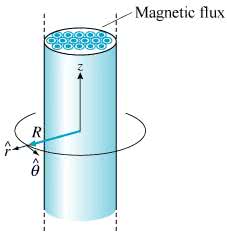PHYS 012A Lecture Notes - Lecture 8: Electric Flux, Dot Product, Surface Charge

Chapter 24: Gauss’s Law 9/25/17
Gauss’s La
- Can be used as an alternative procedure for calculating electric fields
- Based on the inverse square behavior of the electric force between point charges.
- Convenient for calculating the electric field of highly symmetric charge distributions
Electric Flux (units = N*m2/C)
- The amount of electric field that penetrates a surface is the electric flux
- If uniform electric field is directed straight through a surface then:
- The electric flux is proportional to the number of electric field lines penetrating the surface.
- So, if the surface is not perpendicular to the field, it is the component of the area perpendicular
to the field that contributes to the flux.
Uniform Electric Field
- Making angle theta with normal at a surface.
- Flux is a maximum when the surface is perpendicular to the field and theta = 0 degrees.
- Flux is zero when the surface is parallel to the field and theta = 90 degrees.
Dot Product
find more resources at oneclass.com
find more resources at oneclass.com

Open and Closed Surfaces
- A rectangle is an open surface – does’t otai a olue
o Surface normal can be up or down
- A sphere is a closed surface – it does contain a volume
o Surface normal is always outward
Closed Surface
- The vectors point in different directions at different points on the surface
o At each point, they are perpendicular to the surface, and they point outward
Flux through Closed Surface
- The net flux through a closed surface is proportional to the net number of electric field lines
leaving the surface.
o This net number of lines is the number of lines leaving the surface minus the number
entering the surface
Gauss’s La – General
- A positive point charge, q, is located at the center of a sphere of radius r.
- The magnitude of the electric field everywhere on the surface of the sphere is E = keq/r2.
- To find electric flux through the whole sphere:
- The field lines are directed radially outward and are perpendicular to the surface at every point.
- Closed surfaces of various shapes can surround the charge. The net flux through any closed
surface surrounding a point charge q is given by q/epsilono and is independent of the shape of the
surface. The net electric flux through a closed surface that surrounds no charge is zero.\
find more resources at oneclass.com
find more resources at oneclass.com
Document Summary
Can be used as an alternative procedure for calculating electric fields. Based on the inverse square behavior of the electric force between point charges. Convenient for calculating the electric field of highly symmetric charge distributions. The amount of electric field that penetrates a surface is the electric flux. If uniform electric field is directed straight through a surface then: The electric flux is proportional to the number of electric field lines penetrating the surface. So, if the surface is not perpendicular to the field, it is the component of the area perpendicular to the field that contributes to the flux. Making angle theta with normal at a surface. Flux is a maximum when the surface is perpendicular to the field and theta = 0 degrees. Flux is zero when the surface is parallel to the field and theta = 90 degrees. A rectangle is an open surface does(cid:374)"t (cid:272)o(cid:374)tai(cid:374) a (cid:448)olu(cid:373)e: surface normal can be up or down.



